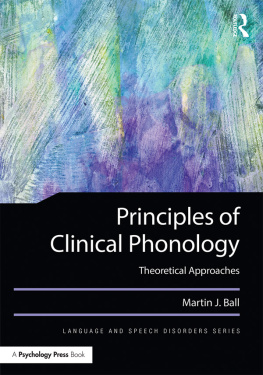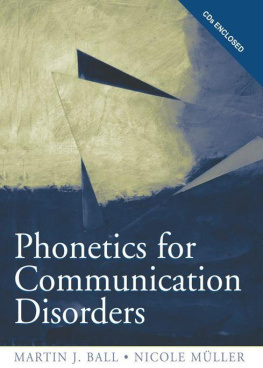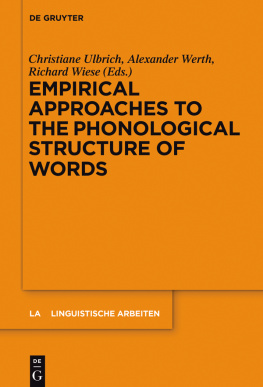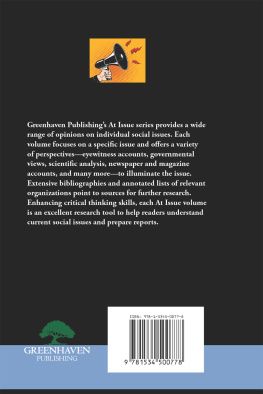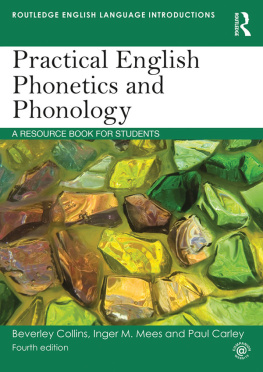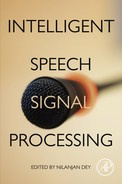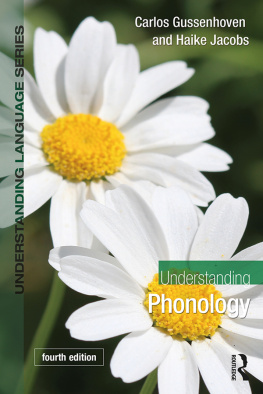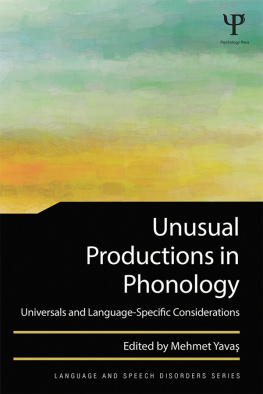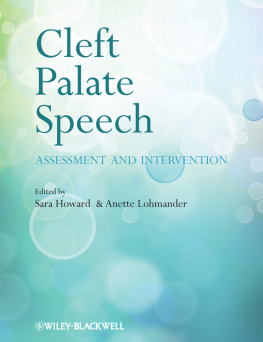Principles of Clinical Phonology
Those working on the description of disordered speech are bound to also be involved with clinical phonology to some extent. This is because interpreting the speech signal is only the first step to an analysis. Describing the organization and function of a speech system is the next step. However, it is here that phonologists differ in their descriptions, as there are many current approaches in modern linguistics to undertaking phonological analyses of both normal and disordered speech.
Much of the work in theoretical phonology of the last fifty years or so is of little use in either describing disordered speech or explaining it. This is because the dominant theoretical approach in linguistics as a whole attempts elegant descriptions of linguistic data, not a psycholinguistic model of what speakers do when they speak. The latter is what is needed in clinical phonology. In this text, Martin J. Ball addresses these issues in an investigation of what principles should underlie a clinical phonology. This is not, however, simply another manual on how to do phonological analyses of disordered speech data, though examples of the application of various models of phonology to such data are provided. Nor is this a guide on how to do therapy, though a chapter on applications is included. Rather, this is an exploration of what theoretical underpinnings are best suited to describing, classifying, and treating the wide range of developmental and acquired speech disorders encountered in the speech-language pathology clinic.
Martin J. Ball is Professor of Speech Language Pathology, specializing in clinical linguistics and phonetics, at Linkping University in Sweden. He has previously held positions in Wales, Ireland, and the United States.
Language and Speech Disorders Book Series
Series Editors:
Martin J. Ball, Linkping University, Sweden
Jack S. Damico, University of Louisiana at Lafayette
This new series brings together course material and new research for students, practitioners, and researchers in the various areas of language and speech disorders. Textbooks covering the basics of the discipline will be designed for courses within communication disorders programs in the English-speaking world, and monographs and edited collections will present cutting-edge research from leading scholars in the field.
Published
Recovery from Stuttering, Howell
Handbook of Vowels and Vowel Disorders, Ball & Gibbon (Eds.)
Handbook of Qualitative Research in Communication Disorders, Ball, Mller & Nelson (Eds.)
Dialogue and Dementia, Schrauf & Mller (Eds.)
Understanding Individual Differences in Language Development Across the School Years, Tomblin and Nippold (Eds.)
Unusual Productions in Phonology: Universals and Language-Specific Considerations, Yavas (Ed.)
Social Communication Development and Disorders, Hwa-Froelich (Ed.)
Principles of Clinical Phonology: Theoretical Approaches, Ball
For continually updated information about published and forthcoming titles in the Language and Speech Disorders book series, please visit www.routledge.com/series/LSD.
Principles of Clinical Phonology
Theoretical Approaches
Martin J. Ball

First published 2016
by Routledge
711 Third Avenue, New York, NY 10017
and by Routledge
2 Park Square, Milton Park, Abingdon, Oxon, OX14 4RN
Routledge is an imprint of the Taylor & Francis Group, an informa business
2016 Taylor & Francis
The right of Martin J. Ball to be identified as author of this work has been asserted by him in accordance with sections 77 and 78 of the Copyright, Designs and Patents Act 1988.
All rights reserved. No part of this book may be reprinted or reproduced or utilised in any form or by any electronic, mechanical, or other means, now known or hereafter invented, including photocopying and recording, or in any information storage or retrieval system, without permission in writing from the publishers.
Trademark notice: Product or corporate names may be trademarks or registered trademarks, and are used only for identification and explanation without intent to infringe.
Library of Congress Cataloging-in-Publication Data
Ball, Martin J. (Martin John)
Principles of clinical phonology : theoretical approaches / by Martin J. Ball.
pages cm
Includes bibliographical references and index.
1.Speech disorders.2.Communicative disorders.I.Title.
RC423.B286 2016
616.855dc23
2015017435
ISBN: 978-1-138-93993-6 (hbk)
ISBN: 978-1-138-93994-3 (pbk)
ISBN: 978-1-315-67098-0 (ebk)
Typeset in Times
by Apex CoVantage, LLC
Contents
Anyone working on the description of disordered speech is almost bound to also be involved with clinical phonology to some extent. Even a phonetic transcription involves decision making by the transcriber as to what to include; even an instrumental analysis involves decision making by the analyst as to how to annotate and describe the results. Interpreting the speech signal, then, is the first step to a phonological analysis; describing the organization and function of a speech system is the next step. However, it is here that phonologists differ in their approaches, as there are many currently used ways of undertaking a phonological analysis in modern linguistics.
It is the premise of this book that much of the work in theoretical phonology of the last fifty years or so, a good deal of which has also been applied to disordered speech data, is of little use in either describing disordered speech or explaining it. This is because, despite the claims of some generative phonologists, the generative enterprise in linguistics as a whole attempts economical and elegant descriptions of linguistic data, not a psycholinguistic model of what speakers do when they speak.
As a result of the imperative for descriptive parsimony, many of the current dominant approaches to phonology use units of analysis and descriptive formalisms that are geared more toward the abstract end of a concreteabstract spectrum. Such abstract devices as binary feature systems, underspecification, and infinite input into an evaluator module may be justifiable in terms of the specific theory, but tell us little about how normal and disordered speech are actually produced.
Nevertheless, models of phonology have been developed over the last several decades that are situated outwith the generative paradigm. These have been concerned less with descriptive parsimony and more with providing descriptions of what speakers do. For example, one model takes articulatory gestures as the prime unit of analysis, another examines phonology as a series of choices that a speaker makes in order to produce meaningful speech, and a third considers phonology from a cognitive viewpoint and analyzes frequency of use as determining phonological storage. It is argued here that all of these approaches have something to offer to clinical phonology.
There are naturally many aspects of a clinical phonological analysis that are theory neutral, but recent research in clinical phonetics has suggested that even surface descriptions of speech patterns in the clinic have to take into consideration both the speakers intention and the listeners perception (which may not be the same). Further, it can be demonstrated that the division into phonetic and phonological disorders is not a straightforward one.

